How Tall Should A Chicken Coop Be? My Quest for Perfect Chicken Raising
- February 8, 2024
- 1 comment
Starting a backyard poultry farm has greatly enhanced my life, providing both the practical advantage of fresh eggs and the less tangible, yet equally valuable, pleasure of forming bonds with these fascinating birds. However, creating a well-functioning backyard coop came with its set of challenges, especially when it came to determining the right height for the chicken coop. Initially, this seemed like a simple task, but it quickly became apparent that it involved a range of detailed considerations and subtle complexities.
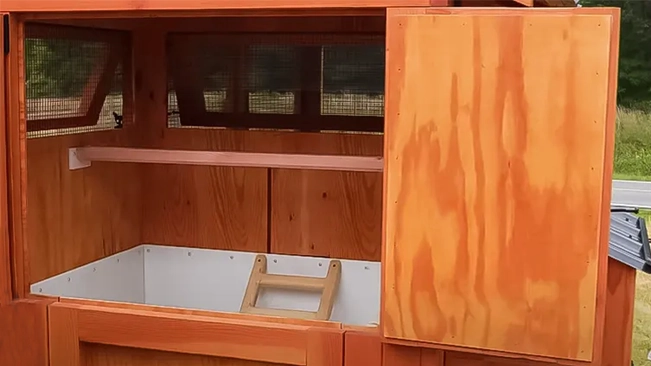
When setting up a chicken coop, while the initial focus might be on its square footage, the importance of the coop’s height is often underestimated, especially by those new to chicken keeping. Adequate vertical space is vital for the chickens’ wellbeing, affecting their comfort and health significantly.
Insufficient height can expose chickens to cold drafts, especially during nighttime roosting, potentially causing discomfort or driving them to seek warmth in nesting boxes, which should be reserved for egg laying.
List of How Tall Should A Chicken Coop Be:
- Improved Ventilation
- Easier Access for Cleaning and Maintenance
- Space for Roosting and Vertical Activities
- Protection from Predators and the Elements
- Accommodating Larger Breeds or More Chickens
A minimum height of about 7.3 feet on the coop’s shortest side is recommended, factoring in the placement of 25-inch high roosting bars, 6 inches of bedding, a 3.5-foot gap to the start of the ventilation area to prevent drafts, and at least 5 inches of ventilation space for proper air quality.
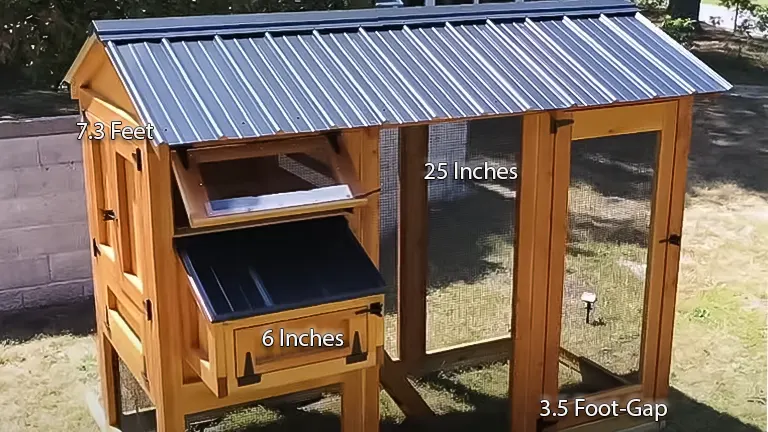
This comprehensive approach to determining coop height addresses the chickens’ diverse needs, ensuring their environment is not only safe and warm but also supports their natural behaviors and promotes their overall comfort.
Why a Chicken Coop Must Be At Least 37.3 Tall?
A chicken coop must be at least 87.6 inches or 7.3 feet tall to accommodate essential aspects of chicken health and comfort, including proper ventilation, space for roosting bars, and adequate room for bedding.
This height allows for the installation of roosting bars at an appropriate level above the ground, ensuring chickens are kept off the cold floor and away from potential predators, while also leaving sufficient space above the roosting bars for effective ventilation without creating drafts.
- Roosting bars elevated above the ground level permit chickens to comfortably move and gather beneath them, optimizing the use of space within the coop.
- Placing roosting bars higher than nesting boxes discourages chickens from sleeping in the boxes, which are intended for egg laying, thus maintaining cleanliness and order.
- Positioning ventilation above the level of roosting bars ensures that while fresh air circulates, it does not create uncomfortable drafts directly on the roosting chickens, promoting their well-being.
- A taller coop design facilitates effective air circulation, crucial for maintaining a healthy environment by removing moisture, ammonia, and reducing the risk of respiratory issues among the chickens.
Additionally, this height supports the inclusion of several inches of bedding material for insulation and hygiene, contributing to a safe and comfortable environment that meets the chickens’ natural behaviors and wellbeing requirements.
5 Justifications for Opting for a Higher Chicken Coop
1. Improved Ventilation
The importance of ventilation in a chicken coop cannot be overstated, as it plays a pivotal role in maintaining a healthy environment for your flock. A taller chicken coop provides a natural convection current; as warm, stale air within the coop heats up, it rises to the top and exits through strategically placed vents or windows.
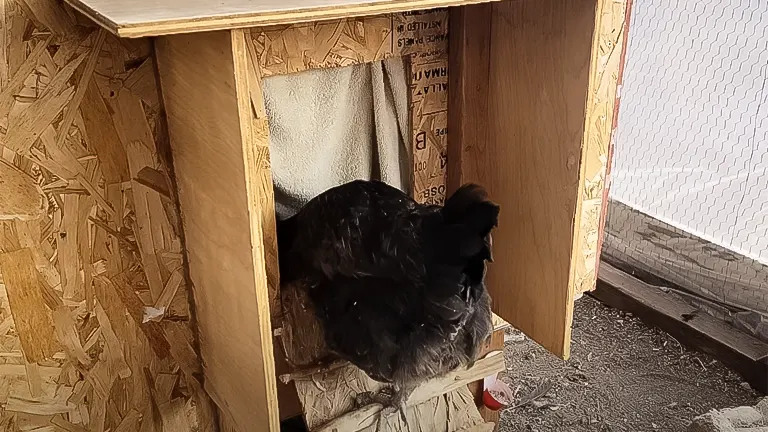
This upward movement of air naturally draws in cooler, fresh air from lower openings or the coop door. This continuous cycle of air exchange ensures that the air inside the coop remains fresh, reducing humidity levels and minimizing the accumulation of harmful ammonia gases from chicken waste. Good ventilation is crucial for preventing respiratory illnesses, which can spread quickly through a flock in poorly ventilated spaces.
By designing a coop with height in mind, you not only create a more comfortable living space for your chickens but also a healthier one, ensuring that fresh air circulates efficiently without creating drafts that could chill your birds, especially during colder months.
2. Easier Access for Cleaning and Maintenance
A taller chicken coop simplifies the tasks of cleaning and maintenance, which are essential for keeping your chickens healthy and your coop in good condition. A coop that’s tall enough to stand in means you won’t have to bend, crouch, or kneel to clean out bedding, refill feeders and waterers, or perform regular maintenance tasks.
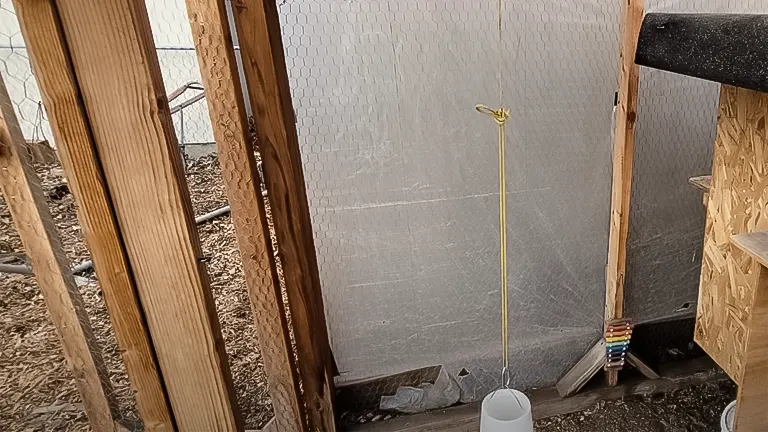
This ease of access encourages more frequent and thorough cleaning, as you can comfortably reach every corner, nesting box, and perch. Regular cleaning is critical to prevent the buildup of droppings, which can harbor pathogens and parasites.

Additionally, being able to stand upright in the coop makes it easier to inspect your chickens closely for signs of illness or injury. This level of accessibility not only makes the coop more hygienic but also lessens the physical strain on you, making chicken keeping a more enjoyable and less daunting task.
3. Space for Roosting and Vertical Activities
Chickens have a natural instinct to roost in high places as a defense mechanism against predators. A taller chicken coop can accommodate this instinctual behavior by allowing for the installation of perches at various heights. This setup provides chickens with the elevated spots they prefer for sleeping, offering a sense of security and hierarchy within the flock, as higher-ranking chickens tend to choose higher perches.
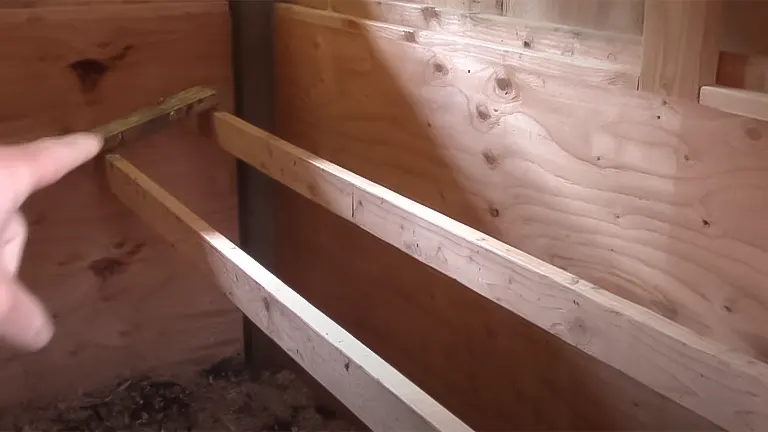
Moreover, a taller coop offers additional vertical space for chickens to engage in natural behaviors, such as flying, jumping, and stretching their wings, which are crucial for their physical health and mental stimulation. This vertical dimension of their living space allows chickens to express their innate behaviors, promoting a more active and healthier lifestyle.
The added height also facilitates the design of a more dynamic and enriching environment, with the possibility of incorporating features such as platforms, ladders, and different levels that encourage exploration and activity.
4. Protection from Predators and the Elements
A taller chicken coop, especially one elevated off the ground, offers enhanced protection against predators and environmental elements. By positioning windows, vents, and the coop entrance higher off the ground, you can significantly reduce the risk of predators reaching your chickens.
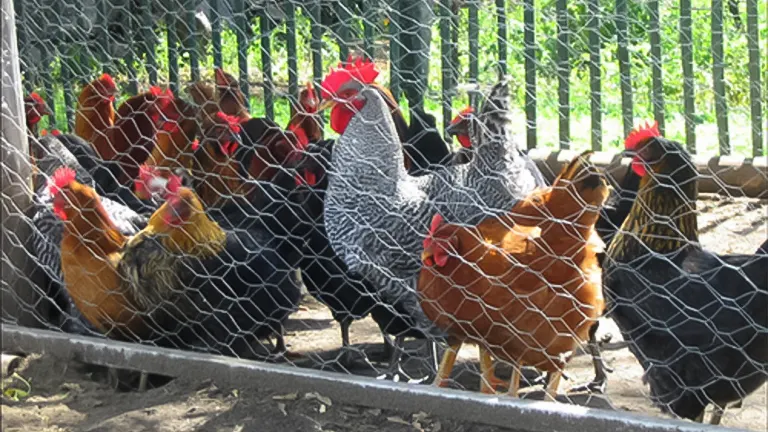
This elevation also prevents direct access to the coop by animals that might dig or chew their way in. Additionally, a taller coop with a sloped roof design ensures better water runoff during rainstorms and easier snow removal in winter, preventing water from pooling and infiltrating the coop.
This design consideration keeps the coop’s interior dry, reducing the risk of damp conditions that can lead to health issues like respiratory infections or foot problems in chickens.
By thoughtfully designing a taller coop, you create a fortress that safeguards your chickens from the threats posed by both predators and harsh weather conditions, ensuring they remain safe, dry, and comfortable throughout the year.
5. Accommodating Larger Breeds or More Chickens
For those who raise larger chicken breeds, such as Jersey Giants or Brahmas, or wish to keep a larger flock, a taller chicken coop is essential to provide adequate space and ensure the well-being of your birds. Larger breeds require more headroom and spacious accommodations to move around comfortably without risking injury. A taller coop allows for the construction of higher perches and more spacious nesting boxes, catering to the needs of larger chickens.
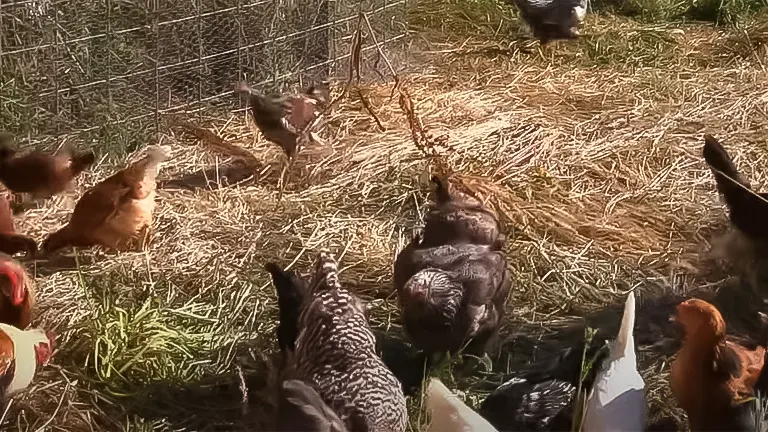
Additionally, the increased vertical space can be ingeniously utilized to include multiple levels or staggered perching areas, effectively maximizing the available living area within the same footprint. This vertical expansion is particularly beneficial in smaller backyards where ground space is limited, allowing you to keep a larger flock without compromising their comfort or health.
By accommodating the specific needs of larger breeds or a greater number of chickens, a taller coop ensures all birds have enough space to live, roost, and engage in natural behaviors, contributing to a harmonious and stress-free environment.
Related Articles:
- Best Bedding For Chickens
- Best Safe Chicken Coop Heater
- 8×8 Chicken Coop Plans
- Turning a Shed Into a Chicken Coop
- How to Make a Chicken Coop Out of Pallets
- Best Sand for Chicken Coop
- How To Insulate a Chicken Coop
- How To Heat a Chicken Coop
- How To Keep Water from Freezing in Chicken Coop
- How to Build a Chicken Coop
- How To Build Chicken Nesting Boxes
- How to Raise Happy and Healthy Chickens in Your Backyard
- When Can Chicks Go Outside? Timing and Tips for a Smooth Transition
- 12 Reasons why Ducks are Better than Chickens
- Best Automatic Chicken Coop Doors 2024: Expert Reviews & Buyer’s Guide
- Best Fans for Chicken Coop 2024: Effective Cooling Solutions Reviewed
Final Insights
To wrap up, the ideal height for a chicken coop can’t be universally defined, as it largely depends on individual circumstances and specific needs. Drawing from my own journey in chicken keeping, I’ve found that targeting a height which facilitates excellent air flow, provides ease of access for maintenance, and allows chickens sufficient room to engage in their instinctual activities is crucial. In my case, a coop that reaches about 8 feet at its tallest section, complemented by a walk-in feature, has been exceptionally effective. This configuration not only caters to the well-being of my chickens, but also significantly simplifies my duties in their care.
It’s important to highlight that the essence of raising chickens extends far beyond the benefit of obtaining fresh eggs; it’s deeply rooted in the commitment to fostering a nurturing and joyful environment for them. Adapting your coop to meet these requirements plays a pivotal role in enhancing your experience as a chicken keeper.
Frequently Asked Questions
- What is the minimum height a chicken coop should be?
The minimum height for a chicken coop should allow chickens to stand upright without their heads touching the ceiling, typically around 2 to 3 feet for the interior space. However, for human access and ease of maintenance, a height of at least 6 feet is recommended to allow most people to stand upright inside. - Does the breed of chicken influence the ideal height of a coop?
Yes, larger breeds such as Jersey Giants or Brahmas will require more headroom compared to smaller breeds. Tailor the coop height to accommodate the specific breeds you plan to keep, ensuring they have enough space to move comfortably and exhibit natural behaviors. - How does coop height affect ventilation?
A taller coop promotes better ventilation by allowing warm, humid air to rise and exit through high vents or windows, while cooler, fresh air enters from below. This helps maintain a healthy environment by reducing the buildup of harmful gases and moisture. - Is it necessary for a chicken coop to have a walk-in design?
While not strictly necessary, a walk-in design (typically around 6 feet or taller) greatly facilitates easier cleaning, maintenance, and interaction with your chickens, making it a preferred option for many keepers. - Can the height of a chicken coop protect against predators?
Yes, a taller coop, especially one raised off the ground, can help deter predators by limiting their access to the chickens through elevated windows and doors. - Should the chicken coop height vary with climate?
In colder climates, a slightly taller coop can help with heat distribution by allowing cold air to settle below the perching area. In warmer climates, additional height can improve ventilation and cooling. - Does a taller chicken coop require more heating in winter?
Potentially, yes. A taller coop has more air volume, which can make it more challenging to keep warm. However, proper insulation and strategic heating can mitigate this issue. - How does coop height impact the chicken’s behavior?
A coop with enough vertical space for perches at various heights can support the chickens’ natural roosting instincts and pecking order, contributing to a harmonious flock by reducing stress and aggression. - Are there any disadvantages to having a taller chicken coop?
The main disadvantages include potential increased costs for construction and heating, as well as the possibility of needing a ladder or steps to access higher areas for cleaning and maintenance. - How can I ensure my tall chicken coop is sturdy and safe?
Ensure the coop is constructed with strong, durable materials and anchored securely to the ground. Consider the wind load in your area, and make sure the roof and walls can withstand local weather conditions. Regularly inspect the coop for any signs of wear or damage that could compromise its integrity.
We’re eager to learn from your journey! Share your stories and insights on determining the ideal height for your chicken coop in the comments section below. Your personal experiences could greatly assist fellow enthusiasts in creating the perfect environment for their flock. Whether it’s lessons learned, innovative solutions, or simply what worked (or didn’t) for you, your contribution can guide others towards making well-informed decisions for their chicken coops!

Edward Smith
Forestry AuthorWoodworking is about more than crafting; it's a harmonious connection with nature, mastering tools, and preserving our environment. I'm here to share my knowledge and experiences with you, forging a future where we can embrace wood's beauty and utility while safeguarding our forests' health and diversity.













that's a good Idea.. Thank you for this!
Paul
February 10, 2024 7:15 pm